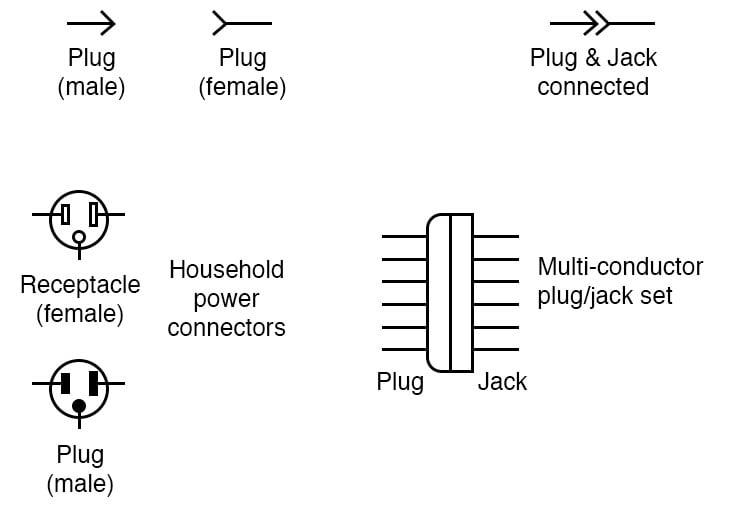The Symbols Of Integrated Circuits: The complete guide
The Symbols Of Integrated Circuits: The complete guide

Image source Wikipedia
Integrated circuits are present in every electronic application. They are used in all electronic devices to perform different functions. These functions include power management, memory management, and data security, among many others. As long as you are in the world of electronics, either as an engineer or technician, it is important to know all the key symbols that are used for representing integrated circuits. This is exactly the primary purpose of this article. We are going to dig deep into different symbols of IC chips. The knowledge of these symbols will be important whenever you will be handling circuit diagrams. Just by looking at the symbol on the diagram, you will be able to tell that it is an integrated circuit and make the necessary connections with the rest of the circuit. Keep reading as we do a comprehensive breakdown of different symbols of integrated circuits.
What is an IC symbol?
First things first, what does the term “integrated circuit symbol” mean? This refers to the graphical representation of a complete IC chip in schematic diagrams. We all know that an integrated circuit comprises a collection of multiple electronic components such as transistors, capacitors, resistors, and transistors among others. All of them are connected to form an integrated circuit.
Why are symbols used for representing integrated circuits? The main reason is to ease communication when working on integrated circuits. Engineers and technicians use the symbols to know the exact positions of the IC chips. This way, they will be able to make perfect connections and integrations in the real circuits.
In schematic diagrams, IC symbols are represented in the form of boxes or rectangle shapes with connecting pins on both sides. These pins represent the electrical connections that should be made with the integrated circuits. Additionally, each pin is numbered to illustrate its specific function on the integrated circuit.
However, you should take note that integrated circuit symbols do not represent the actual physical appearance of the IC chip. Instead, the symbol is just a theoretical representation of the semiconductor chip with its internal components and connections. The symbol makes it easier for us to understand the place of IC chips in schematic diagrams.
These symbols have been created by various major organizations in the world of electronics. They include the Institute of Electrical and Electronics Engineers (IEEE), and the American National Standards Institute (ANSI). The symbols are universally recognized in the field of electronics. This means that the meaning of the symbol will always remain constant regardless of the geographical location.
Common electrical symbols in integrated circuits
Here are some of the most common electrical symbols that are used in integrated circuits.
· IC chip symbol: Well, let’s start with the main symbol of an integrated circuit. It is represented by a rectangular box with pins. These pins represent the terminals onto which you will connect an integrated circuit. The exact number of pins may vary from one IC chip to another.
· Light switch: In an integrated circuit, a light switch is represented by a circle cutting across it. The symbol represents switches that control the flow of electric current in a circuit. The line cutting through the circle may be broken or straight to show that the switch is either closed or open. Also, the symbol represents different types of switches: single-pole switches and double-pole switches.
· Power outlet: A power outlet symbol in an integrated circuit is represented by a square with two lines inside. The lines represent the electrical connections in which you will connect other devices and components to an integrated circuit.
· Resistance: Resistance in an integrated circuit is represented by a zigzag line. It is used to indicate the circuit resistance to the flow of electric current. Keep in mind that resistance is measured in ohms and sometimes this value is indicated next to the zigzag line.
· Condenser: A condenser in an integrated circuit is represented by two parallel lines. This is the same symbol that represents a capacitor in an integrated circuit. Keep in mind that a capacitor is an electronic component that is used for storing electric charges. Its value is measured in farads (F).
· Connector: each integrated circuit comes with connectors. They provide connection points you can connect to the rest of the circuit. A connector can be a male or female depending on the type and nature of connection that you would like to make.
· Inductor: The symbol of an inductor is a coiled wire.
· Photoresistor: This is a light-dependent resistor. Its symbol is represented by a normal resistor symbol that is within a circle. Outside the circle are arrows that represent the source of the light.
· Crystal: A crystal in an integrated circuit is used for creating clock frequency. Its symbol is similar to that of a capacitor only that the middle part has a rectangular box instead of a space.

Image source All About Circuits
· Transformer: A transformer is represented by two coupled coils. The main function of a transformer in an integrated circuit is to change the power levels. It can be from high to low or vice versa.
· Diodes: Diodes are important components of integrated circuits. Their main function is to control and determine the direction of the current flow on IC chips. Although there are different types of diodes, all of them are represented by an arrow pointing toward a specific direction. For example, in the PN junction diode, the arrow will point towards the PN junction. On the other hand, a Zener diode is represented by a Z-shape which is a representation of the Zener property of the diode.
· Transistors: Transistors in most integrated circuits are used as switches and amplifiers. It all depends on their intended purpose. For the NPN transistor, there is an arrow that points from the base to the emitter of the transistor. It depicts that the electric current will be flowing from the collector, passing through the base, and going to the emitter. A schematic symbol for a BJT transistor is a circle that encloses three lines that represent the terminals going into the transistor. For the NPN transistor, the base is usually positioned on the left while the collector is at the top and the emitter symbol is right at the bottom. For the operational amplifier, it is represented by a triangular shape that has two inputs and a single output terminal
· Capacitors: A capacitor is usually represented by two lines that are parallel to each other. These lines represent the two conductive plates of a capacitor. As is the case for the physical capacitor, the space between the plates represents a dielectric material, whose function is to store the electric charges.
· Memory elements: Some IC chips have memory components or devices that are embedded within them. These These are usually represented by two-terminal elements that are asymmetric and next to it is a black thick line. In some schematic diagrams, the memory components are represented as rectangles, and next to the shape is the capacity of the memory.
· Logic gates: Logic gates are also integral components that you will find on integrated circuits. There are different types of logic gates and each type has a special symbol. The AND gate is represented by a D-shaped symbol while the OR Gate is represented by a curved shape that converges at a single point. The NAND gate has a D-shaped symbol and a small circle at the output. Similarly, the NOR Gate symbol is similar to the OR gate but also has a small circle at the output. The XOR Gate is similar to the OR gate only that it has an extra curve at the input side of the symbol.
· Clock signal: A clock signal in a schematic diagram is represented by a square wave and a duty cycle.
Conclusion
A typical intergrade circuit comprises numerous electronic components. Each component has a unique symbol that is used for representing it in a schematic diagram. We have just covered most of these components and you should not have a hard time when it comes to interpreting their symbols.
Would you like to show your prowess in the field of electronics? Start by knowing all the symbols of various electronic components, including the integrated circuits. With the information that we have presented in this guide, you should have an easy time interpreting each symbol of the IC chip. While knowing the symbols may sound theoretical, you will have to use this information practically when it comes to implementing the real circuits.
Beyond knowing the symbols, you should always strive to find the right integrated circuits for your project. The best place to find such is from reliable and reputable IC chip manufacturers and suppliers. This is where Rantle East Electronic comes in. We are a reputable IC chip distributor that is fully committed to meeting the needs of our clients. Having been in the industry for over 20 years, we know the ins and outs of the IC chip market. You should consider contacting us for a smooth delivery of any type of IC chip suitable for your application.
Kevin Chen
Founder / Writer at Rantle East Electronic Trading Co.,Limited
I am Kevin Chen, I graduated from University of Electronic Science and Technology of China in 2000. I am an electrical and electronic engineer with 23 years of experience, in charge of writting content for ICRFQ. I am willing use my experiences to create reliable and necessary electronic information to help our readers. We welcome readers to engage with us on various topics related to electronics such as IC chips, Diode, Transistor, Module, Relay, opticalcoupler, Connectors etc. Please feel free to share your thoughts and questions on these subjects with us. We look forward to hearing from you!







 Start With
Start With Include With
Include With


